Water parameters (temperature, pH, dGH, dKH) of different aquarium kinds
There are quite a number of aquarium water characteristics that can be tested, but not all are worth it in every case. The most important variables in the water are temperature, pH, Hardness, and the various organically produced toxins such as ammonia, nitrite, and nitrate.
- Most important aquarium water characteristics
- Water parameters for different aquarium types
- When and what should you test aquarium water?
Most important aquarium water characteristics
Aquarium temperature
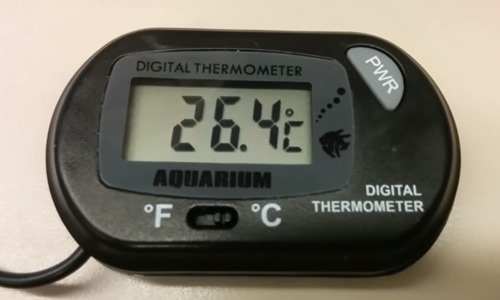
The aquarium temperature is one of the most important factors in a fish’s environment. Unlike mammals, fish are poikilothermic, cold-blooded. This means they do not expend any energy to heat their body.
The result is that their body temperature is very close to the temperature of the water surrounding them, and is entirely regulated by it. Any external thermal changes will result in internal changes as well.
Often fish can become quite stressed with as little a change as 2 degrees in a 24-hour time frame in their aquarium temperature. This has implications when purchasing the heater for the aquarium, the ambient room temperature, and when moving fish from one aquarium to another.
To keep the temperature right for tropical fish, you will need a reliable heater and thermometer. The rule of thumb is using 3.8 watts of heating per gallon (or 1W/L) in an aquarium kept at 78F in a normally warmed room of around 70F. If the room is cooler, then I always go up at least one wattage rating (e.g. 4.8W/GAL instead of 3.8, etc.)
Aquarium pH
pH is possibly the most important water characteristic since it interacts with a number of others. The most important two are hardness and ammonia. More details in the following sections.
The pH scale uses a range between 0 to 14. The lower the number, the more acid the reading. The higher the scale, the more alkaline or basic the measurement. Fish do survive and have adapted to a relatively large range of the middle of the pH scale.
 API pH test kit for freshwater #ad
API pH test kit for freshwater #ad
Depending on the origin, most freshwater tropical fish need a fairly well-controlled water reading that will fall between 6.5 – 8.0 aquarium pH. Some prefer 6.5, others 7.2. It depends on what the fish became adapted to in their native habitat.
Some regions in South America where the water is very soft and acid (pH down to 5.5-6.0) while other freshwater rift lakes of Africa where the water is hard and alkaline (pH over 8.2). For saltwater fish, they have adapted to a higher pH range of 8.4 or so.
It is very important to select fish that are able to thrive in the particular pH of your aquarium. Never mix fish from alkaline and acid areas together.
Bear in mind that your local pet store has probably already acclimated the fish they sell to the pH level of the local water so if you start messing with the “natural” pH levels you are likely to simply end up stressing your new fish.
Fish are not very tolerant of sudden changes in pH. Stress can be quite important in a change of .2 in any given 24 hour period. If you must change the pH to accommodate a fish, plan to do so on a very gradual schedule.
General hardness (GH)
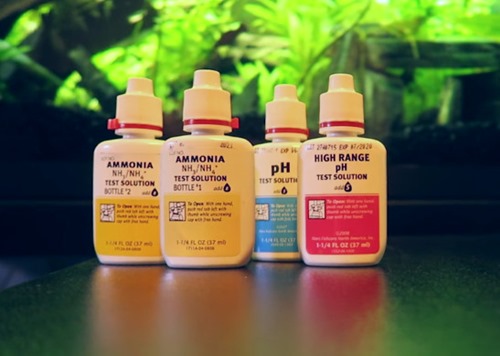
General hardness (GH) is a measurement of the salts dissolved in the water. The main ingredients of aquarium water hardness, as far as the water for aquarium fish is concerned, are calcium (Ca) and magnesium (Mg).
Like fish, shrimps, snails, and corals need minerals from the water to build their skeletal structures. They take these minerals directly from the water through the skin (membrane) and partly from foods.
The hardness of the water will cause differences in the osmotic pump of water passing through the membranes of the fish. The harder the water, the more pressure on the fish to prevent these salts to diffuse into their body.
The less hardness in the water, the less chemical compounds are dissolved in the water. The osmotic pump will try to go the other way and create pressure on the internal salts and other compounds in the fish to try to diffuse to these substances outside their bodies.
The habitat where the fish have evolved will have a great influence on the way the fish are regulating their internal salt content. Soft water and hard water are very different and the direction of water flow can be the opposite.
If the fish are forced to expend their energy protecting their internal composition, this constant stress can cause problems for their health in the long run.
Carbonate hardness (KH)
Alkalinity is the measurement of bicarbonate (HCO3-) and carbonate (CO3-2) ions in the water. Alkalinity refers to the water’s ability to buffer out the effects of acids entering the system and being able to absorb them without any change in pH.
This “buffering” of environmental acids and alkalines means that for the fish, the water pH has a tendency to remain quite constant over time.
However, over time the carbonate hardness of the water will drop due to the constant manufacture of acid within the aquarium due to various life processes such as decay. And pH can slowly overcome the buffering capacity and then drop over time.
Regular testing and occasional addition of a product to increase the KH of the water is often required as the tanks get much older and mature.
If you are keeping live plants, they will also require KH monitoring, especially if an external CO2 is supplied. The carbonic acid that is created when carbon dioxide (CO2) mixes with water will tax the KH of the water. The tank will probably require KH supplementation to keep the water from becoming too acid for both the fish and plants.
You will need to regularly test the KH using a KH test kit #ad, and probably supplement the buffering power if you have a planted aquarium. I strongly recommend the Seachem alkaline buffer.
Ammonia in the aquarium
Fish live and respire, giving off NH3 through the gills as they accept oxygen. Fish also urinate constantly, in order to eliminate the water forcing its way in through simple osmosis. Through this process, ammonia and urea are constantly released into the water.
In addition, in the aquarium, decay bacteria work constantly to reduce wastes (also called mulm including dead plant matters, un-eaten food, dead fish, etc.) to the most simple compounds. As they perform their natural function, NH3 is one of the major by-products.
Chloramines from tap water are also a source of ammonia being added to the aquarium every water change. The water dechlorinator you use will only neutralize the chloramine by breaking the chlorine-ammonia bond. That neutralizes the chlorine but releases the ammonia.
Ammonia (NH3) is a highly toxic gas and increases in the percentage of total nitrogen as the pH rises past neutral (7.0). It becomes more and more deadly as pH rises.
Ammonium (NH4+) is the ionized form and is relatively safe for fish. The lower the pH the higher the ammonium component in the total ammonia test results.
Ammonia test kits commonly read a combination of the two forms of nitrogen compounds – ammonia (NH3) and ammonium (NH4+). They are more or less present as a function of the pH in the aquarium.
In an established (cycled) aquarium, the biological bed (biological filter media, gravel, or any surface that bacteria can colonize) quickly detoxify the ammonia as fast as it is produced. In a new aquarium, beneficial bacteria are either non-existent (brand new) or just starting to populate. It takes a few weeks before the bacteria required to denitrify the molecules and transform them into nitrite.
For aquariums with live animals, ammonia levels should be zero at all times of testing. Ammonia is generally found to increase when the biological filter is either non-existent, not robust enough or has been damaged by something.
Aquarium nitrite
Aquarium nitrite (NO2-) is produced as a part of the chain of reductions that eliminate ammonia from the water, with the help of Nitrifying bacteria. This process is called biological filtration and ends with the growing concentrations of nitrate over time.
Unlike its precursor, ammonia, nitrite is not influenced by other water characteristics such as pH. Nitrite remains toxic whenever it is found in an aquarium. Even small concentrations can be dangerous starting with a concentration of 0.3 mg/L. Nitrite acts directly in the blood system by slowing oxygen adsorption and transportation through the circulatory system.
In an established (cycled) aquarium, the biological bed (biological filter media, gravel, or any surface that bacteria can colonize) quickly detoxify the nitrite as fast as it is produced. In a new aquarium, beneficial bacteria are either non-existent (brand new) or just starting to populate. It takes a few weeks before the bacteria required to denitrify the molecules and transform them into nitrate.
For aquariums with live animals, nitrite levels should be zero at all times of testing (use a nitrite test kit #ad). Nitrite is generally found to increase when the biological filter is either non-existent, not robust enough or has been damaged by something.
Aquarium nitrate
Aquarium nitrate is the final by-product of the nitrogen cycle. It is not very toxic, but it is also extremely stable and is not acted upon by any aerobic bacteria.
Although it is not very toxic, it is still a problem for the aquarium and should be controlled. The normal way to reduce it is through standard partial water changes. When high-concentration nitrate water is partly removed and replaced with new water, the actual nitrate concentration of the aquarium is diluted.
Another natural way to remove nitrate from the aquarium water is growing live plants in the tank or having a refugium (commonly seen in reef filtration systems). The plants use nitrate as part of their fertilizer and will incorporate some into its body, for manual removal.
Metallic ions
There are many elements in nature, when suspended in water, these are often found as metallic ions. Live plants require quite a few of these, in very trace amounts, to grow and thrive. There are many metals that end up in an aquarium.
The two most common are iron and copper. Both can be present in the aquarium as two different forms, ionized and chelated. The ionized forms are toxic to both fish and plants, they are chemically active and dangerous to life.
Chelated metals are those which have been combined with other compounds. This process will create a different composition and, in rational amounts, these are safe. Plants, when they are uptaking the various nutrients, are only able to use metals in their chelated form.
Iron is often part of fertilizer for live aquatic plants. It is given in a chelated or safe form so the plants have no difficulty in assimilating it into their roots and bringing to where they can be used. The best way to deliver it is through a properly formulated plant fertilizer. It is best to use an iron test kit #ad to determine the amount of iron in the aquarium, and dose accordingly.
Copper is used to kill a number of invertebrate pathogens and is particularly deadly in freshwater aquariums with shrimps and snails or marine aquariums. It should never be allowed to get into saltwater installations by any means.
A full-featured water conditioner from API #ad will provide ingredients to neutralize various heavy metals when they are added to tap water. They should be used every time new water is added to the aquarium to prevent any ongoing build-up of concentration that could harm the plants and fish.
Water parameters for different aquarium types
| Tank type | Temperature | pH | dGH | dKH | Ammonia, Nitrite | Nitrate | Salinity |
|---|---|---|---|---|---|---|---|
| Tropical fish tank | 75-80°F (24-27°C) | 6.5-7.5 | 4-12 dGH | 0ppm | < 50ppm | ||
| Shrimp tank | 75-80°F (24-27°C) | 6.5-7.5 | 4-6 dGH | 3-4 dKH | 0ppm | < 50ppm | |
| Planted tank & Discus | 75-80°F (24-27°C) | 6.0-7.5 | 3-8 dGH | 3-8 dKH | 0ppm | < 30ppm | |
| African cichlid tank | 75-80°F (24-27°C) | 7.4-8.6 | 12-20 dGH | 0ppm | < 50ppm | ||
| Central American cichlid | 75-80°F (24-27°C) | 7.0-8.0 | 10-20 dGH | 0ppm | < 50ppm | ||
| South American cichlid | 75-80°F (24-27°C) | 6.0-7.5 | 5-12 dGH | 0ppm | < 50ppm | ||
| Brackish tank | 75-80°F (24-27°C) | 7.5-8.4 | 12-20 dGH | 0ppm | < 50ppm | sg. 1.005-1.010 | |
| Saltwater fish & live rock (FOWLR) | 75-80°F (24-27°C) | 8.1-8.4 | Ca 400ppm Mg 1300ppm |
8-12 dKH | 0ppm | Nitrate < 25ppm Phosphate < 1ppm |
sg. 1.020-1.025 |
| Reef tank | 75-80°F (24-27°C) | 8.1-8.4 | Ca 400ppm Mg 1300ppm |
8-12 dKH | 0ppm | Nitrate < 1ppm Phosphate < 0.2ppm |
sg. 1.023-1.025 |
| Pond | 33 – 86°F (0-30°C) | 6.5-7.5 | 4-12 dGH | 0ppm | < 50ppm | ||
| Axolotl tank | 60 – 64°F (16-18°C) | 6.5-8.0 | 7-14 dGH | 0ppm | < 50ppm | ||
| Turtle tank | water – 72-79°F (22-26°C) air – 91-97°F (33-36°C) |
6.0-8.0 | 10-12 dGH | < 0.25ppm | < 50ppm | 0.5% (5g/l or 0.7oz/gal) |
When and what should you test aquarium water?
Test the water source you use
As someone new to freshwater aquarium keeping you are probably wondering what aquarium test kits you should have and how often you should be doing them.
What you are trying to do through aquarium water tests is to maintain the water quality at a level that is best for your fish so the first thing to do is understand the sort of conditions that your chosen fish prefer. All fish will live happiest between certain water parameters and this varies with each type of fish.
Firstly, test the pH and GH of the water source you use and ensure they are suitable to keep all the fish you plan to have in your aquarium. If they don’t meet the needs of your aquarium fish, you can easily adjust them. There are so many available products in the market that you can use to change (increase/decrease) the pH and GH.
New aquarium testing
In a new tank, there is no nitrogen cycle. The biological filter is not yet established so any fish waste or undigested food will lead to an ammonia spike. This is the first stage of the nitrogen cycle and can be easily detected with an ammonia test.
You need to test aquarium water regularly as the nitrogen cycle gets established.
As the friendly bacteria start to grow you will see the ammonia spike replaced by a nitrite spike as the ammonia is converted to nitrite by the first set of friendly bacteria. This is stage two of the nitrogen cycle and can be tested for with a nitrite test
Finally, as the second set of friendly bacteria take hold you will see the nitrite spike replaced by a nitrate spike. This is the third and final stage of the nitrogen cycle which will show up through a nitrate test.
Depending on whether you are using starter fish to cycle your tank or going the fishless cycle route, these spikes will tend to be more or less extreme. If you are using starter fish, you will need to carry out aquarium water testing frequently and carry out partial water changes to maintain water quality for your fish.
Both ammonia and nitrite are harmful to fish. It is only when nitrite levels have fallen back to their original levels that it is safe to either start adding fish (fishless cycle) or add more fish (starter fish cycle)
Either way make sure that you add the fish slowly, a few at a time, allowing the nitrogen cycle to catch up each time. Test the water every couple of days while you are adding fish and carry out a partial water change (up to 30%) if there is an ammonia or nitrite spike.
This cycling process can take several weeks and you cannot tell which stage you are at without testing the water.
So the three test kits that you definitely need for aquarium water testing simply to monitor the nitrogen cycle are ammonia, nitrite, and nitrate. The fourth that you need is pH to test the acidity of the tank.
Whenever you are introducing fish you need to make sure that there isn’t too big a difference between the pH level in your tank and the pH level of the tank that they came from. If there is you need to acclimatize the fish carefully to avoid shock and stress.
Established aquarium testing
Once your tank has matured, you still need to test but fortunately not as often. Testing your water regularly and making a note of the results can alert you to any changes before they have the chance to turn into problems.
Make it part of your routine to test the water before you carry out your regular water changes, and definitely if your fish are acting differently.
One of the biggest problems in a mature tank is nitrate. Yes, it’s far less dangerous than ammonia and nitrite, but the trouble with nitrate is that it often begins to rise over time. Your planting and regular water changes will go a long way towards dealing with nitrate but it is still worth monitoring on a monthly basis.
One potential problem with high nitrate levels is when you introduce new fish. Unlike your old fish who have gradually become accustomed to your water quality, new fish experience a shock when introduced to a tank with high nitrate levels and can fall ill and die within a week if this is not monitored.
Nitrate is also food for algae which will thrive if levels get too high. Fast-growing plants that soak up the nitrates are your best defense against nitrate build-ups.
Test your water on a regular basis as part of your routine and keep records of the results so that you can spot potential problems. There are other times when you should look at testing as well.
- If you have more than one fish die for no reason, or you lose two or three fish over a few days.
- Your fish start behaving strangely or stop eating
- You have an outbreak of a disease in the aquarium
- You have a power cut off three or more hours
- New fish die within a week
If in doubt, just test! If there is a problem, always do a partial water change on top of your regular maintenance.

 API GH and KH test kit #ad
API GH and KH test kit #ad Seachem alkaline buffer #ad
Seachem alkaline buffer #ad API ammonia test kits #ad
API ammonia test kits #ad API Aquarium Test Kit #ad
API Aquarium Test Kit #ad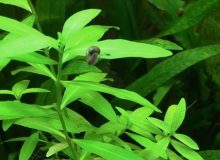
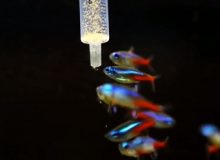
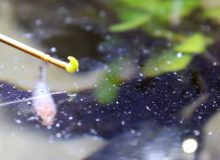
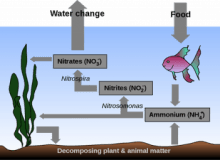
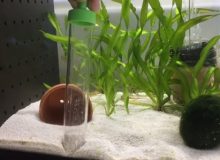
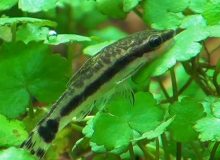
Leave a Reply